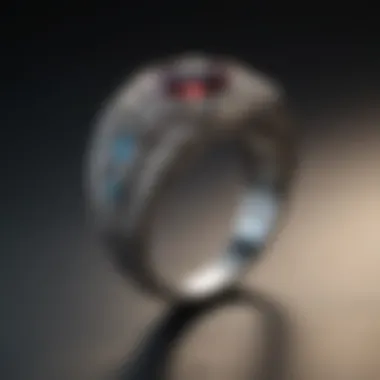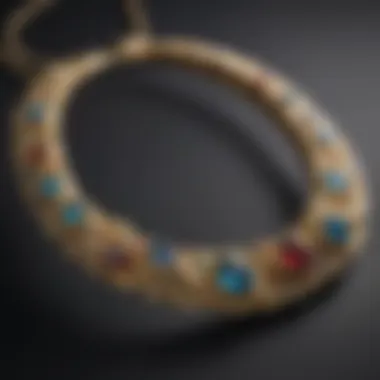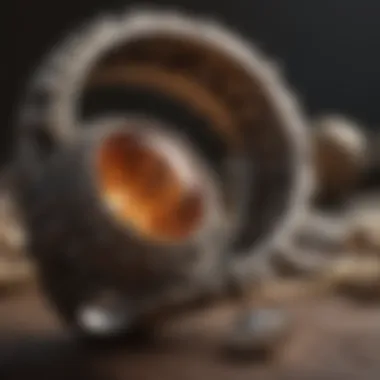Unlocking the Artistry: A Guide to Transforming a Ring into a Necklace


Rock and Fossil Identification
When delving into the fascinating world of transforming a ring into a necklace, understanding rock and fossil identification plays a crucial role in the creative process. In this section, we will explore the various types of rocks and fossils that can be incorporated into jewelry pieces, highlighting their unique characteristics that add to the allure of the final creation. Utilizing specialized tools for identification, such as magnifiers or scratch tests, allows artisans to discern the quality and authenticity of the materials selected for the transformation.
Types of rocks and fossils
Differentiating between sedimentary, igneous, and metamorphic rocks is essential when selecting materials for jewelry making. Each type offers distinct textures, colors, and patterns that contribute to the aesthetic appeal of the final piece. Fossils, with their imprint of prehistoric life forms, add a touch of history and intrigue to the jewelry design.
Characteristics to look for
When scouting for rocks and fossils suitable for transformation, important characteristics to consider include color intensity, hardness, and translucency. Vibrant hues, durability, and the play of light through semi-transparent specimens enhance the visual impact of the jewelry piece, making it a unique and eye-catching accessory.
Tools for identification
Equipping oneself with the right tools is imperative in accurately identifying rocks and fossils. The use of a hardness testing kit, geological hammers, and a UV light can aid in the identification process, ensuring that only high-quality materials are selected for the transformation. These tools not only assist in material selection but also contribute to the overall authenticity and value of the finished necklace.
Introduction
In the vast world of jewelry making, the transformative process of turning a ring into a necklace is a true art form that requires precision and creativity. This article serves as a detailed guide, providing insights and step-by-step instructions for individuals looking to venture into the realm of jewelry transformation. From selecting the right materials to executing intricate modifications, this tutorial offers valuable information to those eager to explore the craft.
Understanding the Concept
Exploring the Idea of Ring to Necklace Conversion
Embarking on the journey of converting a ring into a necklace opens up a realm of creative possibilities. This process allows for the reinvention of jewelry pieces, breathing new life into old treasures. The appeal of repurposing jewelry lies in the opportunity to infuse personal style and meaning into every piece. By transforming a ring into a necklace, individuals can create a unique and personalized accessory that reflects their individuality and creativity.
The Appeal of Repurposing Jewelry
Repurposing jewelry holds a special charm due to its sustainability and uniqueness. This approach not only reduces waste but also adds a sentimental value to the pieces being transformed. The ability to give new life to old jewelry items is what makes repurposing a popular choice among enthusiasts. It allows for the preservation of cherished memories while also showcasing one's creativity and innovative spirit.


Tools and Materials
Essential Tools for Jewelry Modification
Central to the process of transforming a ring into a necklace are essential tools designed for jewelry modification. These tools, ranging from pliers to precision cutters, play a crucial role in achieving precise and clean modifications. Selecting the right tools ensures a smooth and professional transformation process.
Choosing the Right Chain and Clasps
When selecting the chain and clasps for the necklace, considerations such as material, length, and design come into play. The chain serves as the foundation of the necklace, providing both aesthetic appeal and structural support. Similarly, the clasps chosen should be secure and complement the overall design of the piece. Thoughtful selection of chains and clasps is key to achieving a cohesive and visually appealing final product.
Planning the Transformation
Sketching Out Your Design
Before diving into the modification process, sketching out a design blueprint is crucial. This step allows for visualizing the final product, considering elements such as layout, dimensions, and decorative accents. Sketching helps in mapping out the transformation journey, ensuring a cohesive and personalized end result.
Considering Sizing and Proportions
Precision in sizing and proportions plays a vital role in the success of converting a ring into a necklace. Ensuring that the newly crafted necklace fits comfortably and flatters the wearer is essential. Attention to detail in sizing and proportions guarantees a harmonious balance between the ring and the chain, resulting in a polished and well-executed conversion.
Preparing the Ring
When it comes to transforming a ring into a necklace, the crucial step of preparing the ring sets the foundation for a successful jewelry modification process. In this article, focusing on preparing the ring is essential as it ensures that the final piece meets the desired aesthetic and functional requirements. By delving into specific elements such as assessing the ring's structural integrity and employing appropriate cleaning and polishing techniques, individuals can elevate their jewelry-making skills to new heights.
Assessing the Ring
Inspecting for Structural Integrity
Inspecting for structural integrity plays a pivotal role in the overall topic of preparing the ring for transformation. This step involves a detailed examination of the ring to identify any weaknesses, damages, or irregularities that may affect its suitability for becoming a necklace. The key characteristic of inspecting for structural integrity lies in its ability to determine the ring's durability and longevity post-conversion. By conducting this assessment, individuals can ensure that their final piece not only looks visually appealing but also maintains its integrity over time. The unique feature of this inspection method is its precision in identifying microscopic flaws that could compromise the jewelry's functionality. While the advantages of inspecting for structural integrity include a sound foundation for the transformation process, its potential disadvantage may lie in the time-consuming nature of conducting a thorough examination.
Cleaning and Polishing Techniques


The utilization of proper cleaning and polishing techniques contributes significantly to preparing the ring for its new role as a necklace. This aspect involves removing any impurities, tarnish, or scratches on the ring's surface to enhance its luster and appearance. By highlighting the key characteristic of thorough cleaning and polishing, individuals can ensure that the final piece shines radiantly after the transformation. The unique feature of these techniques lies in their ability to revive the ring's beauty and make it ready for a fresh purpose. While the advantages of cleaning and polishing techniques include restoring the ring's original charm, the potential disadvantage may involve the risk of over-polishing, leading to a loss of intricate details in the jewelry.
Adjusting the Ring
Resizing the Ring if Necessary
The process of resizing the ring, if deemed necessary, is a crucial consideration when preparing the ring for transformation. This step involves altering the ring's size to fit the desired necklace design effectively. The key characteristic of resizing the ring lies in its ability to ensure a seamless integration into the new jewelry piece. By emphasizing this adjustment, individuals can tailor the ring to suit the necklace's proportions perfectly. The unique feature of this resizing process is its attention to detail, ensuring a customized fit for the finalized necklace. While the advantages of resizing the ring include a personalized touch to the jewelry, the potential disadvantage could involve compromising the ring's original design elements during resizing.
Avoiding Damage During Modifications
Another vital aspect of preparing the ring is the meticulous process of avoiding damage during modifications. This step entails careful handling and precise execution to safeguard the ring's structural integrity throughout the transformation. The key characteristic of preventing damage lies in the preservation of the ring's original quality and aesthetics. By prioritizing this precaution, individuals can mitigate the risk of unintended consequences during the modification phase. The unique feature of this protective measure is its proactive approach to maintaining the ring's intrinsic value during the conversion process. While the advantages of avoiding damage include a pristine final outcome, the potential disadvantage may involve the need for increased attention to detail and expertise to prevent mishaps.
Creating the Necklace
One of the pivotal stages in the process of transforming a ring into a necklace is creating the necklace itself. This section plays a crucial role in the culmination of the entire project, as it involves the assembly of components that will define the final piece. The necklace serves as the foundation upon which the ring will be incorporated, providing both aesthetic appeal and structural integrity. Choosing the right chain and clasps is essential here, as they not only complement the design but also determine the functionality and wearability of the finished necklace.
Building the Chain Assembly
Connecting the Clasp
When it comes to connecting the clasp, precision and durability are paramount. The clasp serves as a crucial element that not only secures the necklace around the wearer's neck but also adds a touch of sophistication to the design. Selecting a high-quality clasp ensures longevity and ease of use, making the necklace both stylish and practical. The choice of clasp can vary based on the design aesthetic and desired level of security, with options ranging from lobster clasps to spring rings.
Adding Decorative Elements
Incorporating decorative elements into the chain assembly elevates the visual appeal of the necklace. Whether it's adding gemstones, charms, or intricate metalwork, these embellishments contribute to the overall charm and uniqueness of the piece. Each decorative element is carefully selected to harmonize with the design of the necklace while providing a personalized touch. The interplay between the chain assembly and decorative elements creates a visually captivating piece that reflects the creativity and craftsmanship behind the transformation.
Incorporating the Ring
Attaching the Ring to the Chain
The process of attaching the ring to the chain involves meticulous attention to detail to ensure a seamless integration. The ring serves as the focal point of the necklace, anchoring the design and adding a distinctive feature to the piece. By securely attaching the ring to the chain, the craftsmanship and ingenuity of the jewelry maker are emphasized, culminating in a cohesive and visually striking composition.


Ensuring Secure Fastening
Ensuring secure fastening is essential to guarantee the longevity and wearability of the necklace. By employing secure fastening techniques, such as soldering or welding, the bond between the ring and chain is fortified, preventing any risk of detachment or damage. The method chosen for fastening should align with the materials used and the design aesthetics, maintaining both the visual appeal and structural integrity of the necklace.
Final Touches and Finishing
Checking for Balance and Symmetry
Prior to finalizing the necklace, checking for balance and symmetry is vital to achieving a polished and harmonious outcome. Balancing the elements of the necklace ensures that each component complements the others, creating a visually pleasing arrangement. Symmetry, on the other hand, harmonizes the design, enhancing its aesthetic appeal and overall coherence. By meticulously inspecting the necklace for balance and symmetry, any discrepancies can be rectified, refining the piece to perfection.
Polishing and Presenting the Necklace
Polishing and presenting the necklace is the concluding step in the transformation process, adding the finishing touches to the piece. Polishing enhances the luster and shine of the materials, giving the necklace a glamorous sheen. Presentation involves showcasing the necklace in a way that highlights its beauty and craftsmanship, making it ready to be worn or displayed. By meticulously polishing and presenting the necklace, its elegance and allure are brought to the forefront, ready to captivate admirers and convey the creativity and skill invested in its creation.
Conclusion
In the grand scheme of jewelry transformation, the conclusion serves as a pivotal moment where the fruits of labor culminate into a work of art. This article on transforming a ring into a necklace not only provides a step-by-step guide but also emphasizes the significance of embracing creativity in the realm of jewelry making. It encapsulates the essence of repurposing and reviving existing jewelry pieces, breathing new life into them. The transformative journey from a simple ring to a versatile necklace is a testament to the endless possibilities within the craft. By appreciating the art of upcycled jewelry and personalizing one's creations, individuals can find joy in the process and pride in the final outcome. Exploring further possibilities opens doors to experimenting with different designs, expanding skill sets, and pushing creative boundaries. Each crafted piece becomes a unique reflection of the maker's vision and skill, making the conclusion a celebration of craftsmanship and ingenuity.
Appreciating the Transformation
The Unique Appeal of Upcycled Jewelry
As we unravel the layers of upcycled jewelry, a distinct charm emerges from the fusion of history and innovation. The unique appeal lies in its sustainability aspect—breathing new life into existing pieces, reducing waste, and creating environmentally conscious adornments. Upcycled jewelry carries a narrative within its elements, infusing character and depth that mass-produced pieces may lack. This personalized touch resonates with individuals seeking one-of-a-kind accessories that bear a story. The advantage of upcycled jewelry in this article is its ability to transcend trends, offering timeless pieces that stand out amidst ephemeral fads. The tactile quality of repurposed materials adds an authentic feel to each creation, setting them apart in a world of mass consumption. While the process may require more effort and skill, the end result is a masterpiece that not only dazzles the eyes but also resonates with a deeper sense of value.
Personalizing Your Creations
In the realm of jewelry making, personalization reigns supreme as a means of self-expression and individuality. The act of infusing one's creations with personal touches elevates them from mere accessories to wearable art with sentimental value. Personalizing your creations allows for a deeper connection between the maker and the piece, adding layers of meaning and significance. It enables individuals to craft jewelry that aligns with their tastes, preferences, and stories, transforming them into wearable manifestations of creativity. The benefit of personalization in this article is its capacity to cater to diverse styles and occasions, ensuring that each piece resonates with its intended wearer. While the process demands attention to detail and a keen eye for design, the satisfaction of wearing a piece that bears a personal imprint is unparalleled and elevates the experience of jewelry making.
Exploring Further Possibilities
Experimenting with Different Designs
The exploration of different designs opens doors to endless creative possibilities in jewelry making. By daring to push boundaries and embrace novelty, individuals can elevate their craft and unlock new avenues for expression. Experimenting with design not only fosters innovation but also nurtures a sense of curiosity and artistic growth. The key characteristic of experimenting with different designs lies in its capacity to break free from conventions and chart new territories in jewelry making. By embracing experimentation, artisans can discover their unique voice and style, setting them apart in a saturated market. While experimentation may involve risks and challenges, the rewards of uncovering fresh aesthetics and design elements make the journey worthwhile.
Expanding Your Jewelry Making Skills
The pursuit of expanding jewelry making skills is a constant evolution towards mastery and proficiency. As artisans delve deeper into the craft, they acquire new techniques, enhance their craftsmanship, and broaden their creative horizons. The key characteristic of expanding one's jewelry making skills lies in the relentless pursuit of growth and improvement. By honing existing skills and venturing into uncharted territories, individuals can challenge themselves to reach new heights of artistry and innovation. The benefit of expanding skills in this article is the empowerment it brings—equipping artisans with the tools to bring their visions to life with precision and finesse. While the journey towards mastery may be arduous and demanding, the fulfillment of seeing one's skills evolve and creations flourish is a reward that transcends the challenges along the way.







